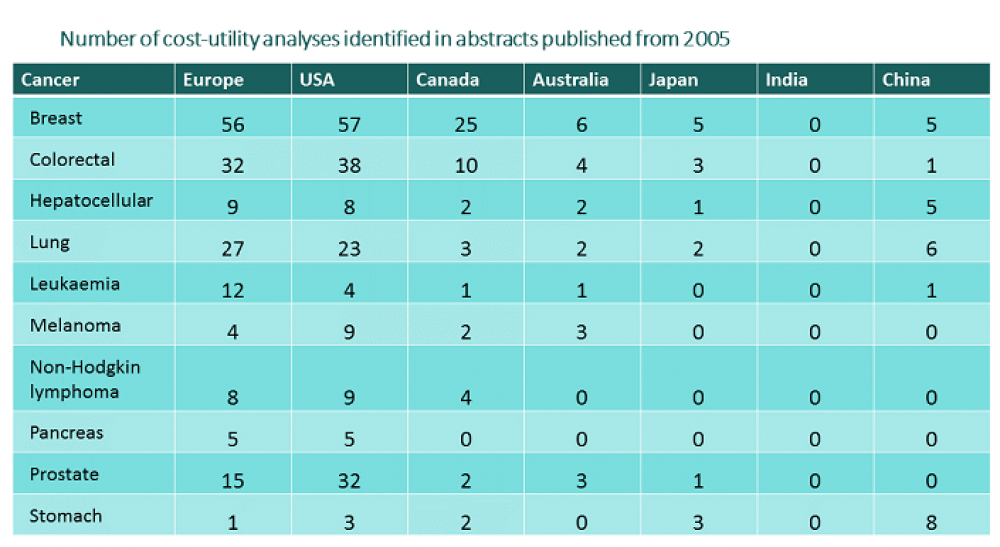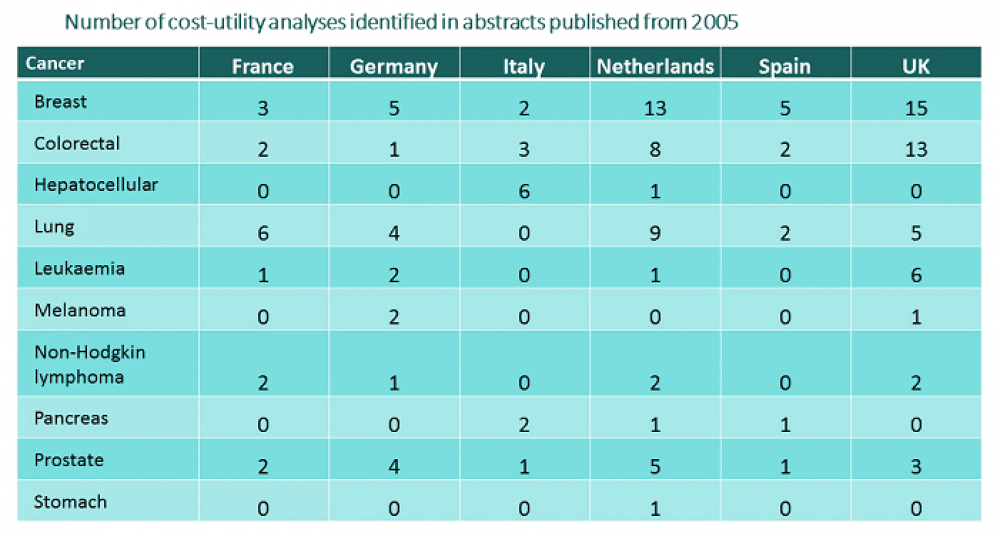An effortless and comprehensive approach to burden of illness reviews
Blog - COST-UTILITY MODELS IN CANCER - GEO-DISTRIBUTION
Published: 28-06-2016
The heoro.com database can be used to rapidly identify economic models by geographical location. Here, we show the number of studies reporting cost-utility models in cancer by key jurisdictions, and discuss how well the focus of health economic research matches mortality data from each country. With the increasing focus on saving money in healthcare and getting more value from services and interventions, it is now difficult for pharmaceutical companies to launch a new product internationally without demonstrating its cost-effectiveness. Conducting an economic evaluation is a common, late stage in the evidence generation plan for most new drugs or biological treatments, and is often based around a cost-utility model. Identifying existing economic models for a specific disease is a requirement for some Health Technology Assessments, such as for the National Institute for Health and Care Excellence. Generating an evidence map of new cost-utility publications is also a way of assessing the focus of research into new treatments for diseases and how this varies by geographical setting. Yet finding relevant publications can be time-consuming, with no standard MeSH codes for different economic models or newer drug names, and geographical locations not always easy to identify. The heoro.com database contains more than 100,000 abstracts from PubMed, published since 2005, which have been indexed by study type and methodology as well as being mapped to detailed ontologies for diseases, interventions and patient-reported outcome measures. The boolean search filter means that it is very quick to identify certain study types that have been published for selected diseases in specific locations. The tables below show the number of abstracts of cost-utility studies indexed in the heoro.com database in June 2016, for ten common cancers across twelve countries. Finding these study counts took less than an hour - considerably less time than it would take to run specific searches of PubMed and screen the results. Cost-utility studies for ten common cancers by geographical setting - World  Cost-utility studies for ten common cancers by geographical setting - Europe
Cost-utility studies for ten common cancers by geographical setting - Europe  More cost-utility studies in our database were for breast cancer treatments than for the other nine types of cancer in both Europe and North America, followed by colorectal cancer. In Europe, lung cancer was third in the list, followed by prostate cancer, although this pattern was reversed in the US. Liver (or hepatocellular) cancer was fifth overall for cost-utility analyses, followed by non-Hodgkin's lymphoma, leukaemias, malignant melanoma, stomach cancer and pancreatic cancer. However, when we look at the number of deaths from each of these ten cancers in the twelve countries, we get a different picture. Using data from the World Health Organization on estimated deaths per thousand by cause, sex and WHO Member State for 2012, cancer of the lung, trachea and bronchus accounted for more than twice as many deaths in total across the twelve countries than liver cancer, which was the second most common cause of death. Lung cancer accounted for 4.1% of all deaths in these countries, with liver cancer 1.9% of all deaths, stomach cancer 1.8%, colorectal cancer 1.6% and breast cancer 1% of all deaths. Pancreatic cancer accounted for 0.8% of all deaths, followed by lymphomas and multiple myeloma (0.6%), leukaemia (0.6%), prostate cancer (0.5%) and melanoma and other skin cancers (0.2%). This brief study suggests that there is a preponderance of research on new interventions for breast and colorectal cancer, and a relative lack of development of new products for other common causes of death such as stomach and pancreatic cancer. This suggests that the poor prognosis of these latter two types of malignancy may not be improving in the near future, and that there is still considerable unmet need for new treatments for these important causes of death.
More cost-utility studies in our database were for breast cancer treatments than for the other nine types of cancer in both Europe and North America, followed by colorectal cancer. In Europe, lung cancer was third in the list, followed by prostate cancer, although this pattern was reversed in the US. Liver (or hepatocellular) cancer was fifth overall for cost-utility analyses, followed by non-Hodgkin's lymphoma, leukaemias, malignant melanoma, stomach cancer and pancreatic cancer. However, when we look at the number of deaths from each of these ten cancers in the twelve countries, we get a different picture. Using data from the World Health Organization on estimated deaths per thousand by cause, sex and WHO Member State for 2012, cancer of the lung, trachea and bronchus accounted for more than twice as many deaths in total across the twelve countries than liver cancer, which was the second most common cause of death. Lung cancer accounted for 4.1% of all deaths in these countries, with liver cancer 1.9% of all deaths, stomach cancer 1.8%, colorectal cancer 1.6% and breast cancer 1% of all deaths. Pancreatic cancer accounted for 0.8% of all deaths, followed by lymphomas and multiple myeloma (0.6%), leukaemia (0.6%), prostate cancer (0.5%) and melanoma and other skin cancers (0.2%). This brief study suggests that there is a preponderance of research on new interventions for breast and colorectal cancer, and a relative lack of development of new products for other common causes of death such as stomach and pancreatic cancer. This suggests that the poor prognosis of these latter two types of malignancy may not be improving in the near future, and that there is still considerable unmet need for new treatments for these important causes of death.